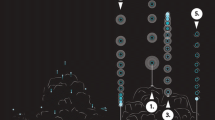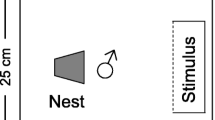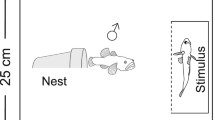Abstract
Neanthes acuminata Ehlers (1868) is a monogamous coastal polychaete with male parental care and a high level of sexual selection. We measured the level of prezygotic isolation among allopatric populations of N. acuminata; from the East and West Coast of the USA, a population from Hawaii, and a laboratory culture originating from Los Angeles, CA. All populations were found to preferably mate with members of their own population. Individuals from populations from Atlantic vs. Pacific Ocean failed to pair and to mate, either during the 10 min or 48 hr experiments. Instead, individuals showed high levels of aggressive behavior. Experiments measuring the levels of interpopulation aggression, established that individuals can recognize and discriminate among different populations of N. acuminata on the basis of olfactory cues. Aggressive behavior was induced by exposure of animals to seawater “conditioned” by individuals from the other populations, thus demonstrating the role of olfaction in the detection of “home” populations. The aggressive display was stronger upon exposure to seawater conditioned with “unrelated” populations and especially between Pacific and Atlantic populations.


Similar content being viewed by others
References
M. Ayasse J. Birnbaum Tengö A. Doorn Particlevan T. Taghizadeh W. Francke (1999) ArticleTitleCaste- and colony specific chemical signals on eggs of the bumblebee Bombus terrestris L. (Hymenoptera: Apidae) Chemoecology 9 119–126
M. G. Bentley A. A. Pacey (1992) ArticleTitlePhysiological and environmental control of reproduction in polychaetes Oceanogr. Mar. Biol., Annu. Rev. 30 443–481
Y. Boilly-Marer B. Lassalle (1980) ArticleTitleElectrophysiological responses of the central nervous system in the presence of homospecific and heterospecific sex pheromones in Nereids (Annelida, Polychaeta) J. Exp. Zool. 213 33–39
E. L. Brannon T. P. Quinn (1990) ArticleTitleField test of the pheromone hypothesis for homing by Pacific salmon J. Chem. Ecol. 16 603–609
T. Breithaupt J. Atema (2000) ArticleTitleThe timing of chemical signaling with urine in dominance fights of male lobsters (Homarus americanus) Behav. Ecol. Sociobiol. 49 67–78
T. Breithaupt P. Eger (2002) ArticleTitleUrine makes the difference: chemical communication in fighting crayfish made visible J. Exp. Biol. 205 1221–1231
M. C. Bull C. L. Griffin E. J. Lanham G. R. Johnston (2000) ArticleTitleRecognition of pheromones from group members in a gregarious lizard, Egernia stokesii J. Herpetol. 34 92–99
P. J. Bushmann J. Atema (2000) ArticleTitleChemically-mediated mate location and evaluation in the lobster, Homarus americanus J. Chem. Ecol. 26 893–900
R. L. Caldwell (1982) ArticleTitleInterspecific chemically mediated recognition in two competing stomatopods Mar. Behav. Physiol. 8 189–197
R. T. CardÉ (1986) Epilogue: behavioral mechanisms T. L. Payne M. C. Birch C. E. J. Kennedy (Eds) Mechanisms in Insect Olfaction Clarendon Press Oxford 175–186
W. E. Cooper SuffixJr. J. H. Wyk Particlevan P. L. E. F. N. Mouton (1999) ArticleTitleDiscrimination between self-produced pheromones and those produced by individuals of the same sex in the lizard Cordylus cordylus J. Chem. Ecol. 25 197–208
Day, J. 1973. New Polychaeta from Beaufort, with a key to all species recorded from North Carolina. NOAA Tech. Rpt., NMFS, NOAA, circ-375, Washington, DC, USA.
M. W. Denny M. F. Shibata (1989) ArticleTitleConsequences of surf zone turbulence for settlement and external fertilization Am. Nat. 134 859–889
M. L. Evenden B. G. Spohn A. J. Moore R. F. Preziosi K. F. Haynes (2002) ArticleTitleInheritance and evolution of male response to sex pheromone in Trichoplysia ni (Lepidoptera: Noctuidae) Chemoecology 12 53–59
C. Gemeno A. J. Moore R. F. Preziosi K. F. Haynes (2001) ArticleTitleQuantitative genetics of signal evolution: A comparison of the pheromonal signal in two populations of the cabbage looper, Trichoplysia ni Behav. Genet. 31 157–165
J. D. Hardege (1999) ArticleTitleNereidid polychaetes as model organism for marine chemical ecology: A review Hydrobiologia 402 145–161
J. D. Hardege H. Bartels-Hardege E. Zeeck F. T. Grimm (1990) ArticleTitleInduction of swarming of Nereis succinea Mar. Biol. 104 291–295
J. D. Hardege H. D. Bartels-Hardege Y. Yu M. Y. Zhu B. L. Wu E. Zeeck (1994) ArticleTitleEnvironmental control of reproduction of Perinereis nuntia var. brevicirrus J. Mar. Biol. Assoc. U.K. 74 903–918
J. Hurst C. E. Payne C. M. Nevison A. D. Marie R. E. Humphries D. H. L. Robertson A. Cavaggioni R. L. Beynon (2001) ArticleTitleIndividual recognition in mice mediated by major urinary proteins Nature 414 631–634
C. Karavanich J. Atema (1998) ArticleTitleIndividual recognition and memory in lobster dominance Anim. Behav. 56 1553–1560
L. C. McLaughlin J. Walters J. Atema N. Wainwright (1999) ArticleTitleUrinary protein concentration in connection with agonistic interactions in Homarus americanus Biol. Bull. 197 254–255
C. M. Nevison C. B. Barnard R. Beynon J. L. Hurst (2000) ArticleTitleThe consequences of inbreeding for recognizing competitors Proc. R. Soc. Lond., Sect. B. 267 687–694
C. A. Palmer S. Edmands (2000) ArticleTitleMate choice in the face of both inbreeding and outbreeding depression in the intertidal copepod Tigriopus californicus Mar. Biol. 136 693–698
G. G. Pesch C. E. Pesch C. Müller (1988) ArticleTitleChromosome complements from two populations of the marine worm Neanthes arenaceodentata (Annelida, Polychaeta) Ophelia 28 163–167
M. H. Pettibone (1963) Marine polychaete worms of the New England region 1. Aphroditidae through Trochochaetidae Smithsonian Inst. Bull., 227 part 1 Washington, DC, USA
D. J. Reish (1957) ArticleTitleThe life history of the polychaete Neanthes caudata (delle Chiaije) including a summary of the development in the family Nereidae Pac. Sci. 11 216–228
D. J. Reish (1985) ArticleTitleThe use of the polychaetous annelid Neanthes arenaceodentata as a laboratory experimental animal Tethys. 11 335–341
D. J. Reish M. C. Alosi (1968) ArticleTitleAggressive behavior in the polychaetous annelid family Nereidae Bull. S. C. Acad. Sci. 67 21–28
D. J. Reish G. C. Stevens (1969) ArticleTitleUptake of organic material by aquatic invertebrates: V. The influence of age on the uptake of glycine-C14 by the polychaete Neanthes arenaceodentata Mar. Biol. 3 352–355
F. Rodriguez-Trelles J. R. Weinberg F. J. Ayala (1996) ArticleTitlePresumptive rapid speciation after a founder event in a laboratory population of Nereis: Allozyme electrophoretic evidence does not support the hypothesis Evolution 50 457–461
S. M. Rollmann L. D. Houck R. C. Feldhoff (2000) ArticleTitlePopulation variation in salamander courtship pheromones J. Chem. Ecol. 26 2713–2724
D. J. Solomon (1973) ArticleTitleEvidence for pheromone influenced homing by migrating Atlantic salmon, Salmo salar (L.) Nature 244 231–232
M. J Stanhope M. M. Connelly B. Hartwick (1992) ArticleTitleEvolution of a crustacean chemical communication channel: behavioral and ecological genetic evidence for a habitat-modified, race-specific pheromone J. Chem. Ecol. 18 1871–1887
Starczak, V. R. 1984. Sexual selection and intrasexual aggression in the marine polychaete Nereis (Neanthes) acuminata. Ph.D. dissertation. Univ. Connecticut, Storrs, CT, USA.
J. R. Weinberg V. R. Starczak C. MÜller G. C. Pesch S. M. Lindsay (1990) ArticleTitleDivergence between populations of a monogamous polychaete with male parental care: Premating isolation and chromosome variations Mar. Biol. 107 205–213
J. R. Weinberg V. R. Starczak D. Jörg (1992) ArticleTitleEvidence for rapid speciation following a founder event in the laboratory Evolution 46 1214–1220
K. Yamazaki A. Singer G. K. Beauchamp (1999) ArticleTitleOrigin, function and chemistry of H-2 regulated odorants Genetica 104 235–240
E. Zeeck T. Harder M. Beckmann C. T. Müller (1996) ArticleTitleMarine gamete-release pheromones Nature 382 214
E. Zeeck C. T. Müller M. Beckmann J. D. Hardege U. Papke V. Sinnwell F. C. Schröder W. Francke (1998) ArticleTitleCysteine–glutathione disulfide, the sperm-release pheromone of the marine polychaete Nereis succinea (Annelida: Polychaeta) Chemoecology 8 33–38
Acknowledgments
We thank Dr. Jim Weinberg for kindly providing us with the Neanthes cultures and fruitful discussions, Dr. T. Breithaupt for help on statistics, and J. Duck and V. Swetez for assistance with the culture of the worms. The authors gratefully acknowledge funding for this work by the Royal Society and by the Marine Biological Laboratory, Woods Hole, through a summer research fellowship to J.D.H.
Author information
Authors and Affiliations
Corresponding author
Rights and permissions
About this article
Cite this article
Sutton, R., Bolton, E., Bartels-Hardege, H.D. et al. Chemical Signal Mediated Premating Reproductive Isolation in a Marine Polychaete, Neanthes acuminata (Arenaceodentata). J Chem Ecol 31, 1865–1876 (2005). https://doi.org/10.1007/s10886-005-5931-8
Received:
Revised:
Accepted:
Published:
Issue Date:
DOI: https://doi.org/10.1007/s10886-005-5931-8




